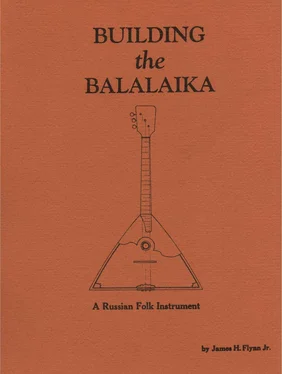James Flinn - Building the Balalaika
Здесь есть возможность читать онлайн «James Flinn - Building the Balalaika» весь текст электронной книги совершенно бесплатно (целиком полную версию без сокращений). В некоторых случаях можно слушать аудио, скачать через торрент в формате fb2 и присутствует краткое содержание. Год выпуска: 1984, ISBN: 1984, Жанр: Руководства, music, на английском языке. Описание произведения, (предисловие) а так же отзывы посетителей доступны на портале библиотеки ЛибКат.
- Название:Building the Balalaika
- Автор:
- Жанр:
- Год:1984
- ISBN:0-9613258-0-1
- Рейтинг книги:4 / 5. Голосов: 1
-
Избранное:Добавить в избранное
- Отзывы:
-
Ваша оценка:
- 80
- 1
- 2
- 3
- 4
- 5
Building the Balalaika: краткое содержание, описание и аннотация
Предлагаем к чтению аннотацию, описание, краткое содержание или предисловие (зависит от того, что написал сам автор книги «Building the Balalaika»). Если вы не нашли необходимую информацию о книге — напишите в комментариях, мы постараемся отыскать её.
Building the Balalaika — читать онлайн бесплатно полную книгу (весь текст) целиком
Ниже представлен текст книги, разбитый по страницам. Система сохранения места последней прочитанной страницы, позволяет с удобством читать онлайн бесплатно книгу «Building the Balalaika», без необходимости каждый раз заново искать на чём Вы остановились. Поставьте закладку, и сможете в любой момент перейти на страницу, на которой закончили чтение.
Интервал:
Закладка:
There does not appear to be any rigid conventions for the species of wood used for the body of the balalaika. If indeed there is a preference, it would be for hard maple. Either sugar maple (Acer saccharinum Marsh.) or black maple (Acer nigrum Michx. f.) being satisfactory. Highly figured wood with curly, birds-eye, quilted or crotch patterns tastefully placed and matched make balalaikas an instrument of beauty. The wood for the head and neck as well as for the smaller components such as binding, corner decorations, etc., should match or complement the wood used for the body. The fretboard, holding to convention and preferences of most musicians, should be made of ebony. Preference for hard maple for the body does not imply that other woods commonly used in musical instrument construction such as rosewood (Dalber-gia sp.), hormingo (Platymiscium sp.), mahogany (Swietenia sp.) etc., are to be excluded from use in making a balalaika. In scoring the value of an instrument it is its musical quality that counts.
The physical attractiveness of an instrument also rates highly and there is all the reason in the world to believe that the balalaika can satisfy both visually as well as musically. So have at it with the species of wood you decide to use!
Old furniture, incidentally, is an excellent source of well-cured wood. One of the better dulcimers I made came from a mahogany mantle removed from an old estate in the Washington, D. C. area. Another example was last year when I was up in Maine and visited a secondhand furniture store in Portland. I found two beautiful bed rails made from birds-eye maple and offered the proprietor 35.00 for the pair. He didn't accept. The rails still sit there and the next time I visit the place I may make an offer of 310.00. I estimate that there is six board feet of usable stock in the rails. You can make an awful lot of prima balalaikas from two bed rails. They may even be worth $15.00!
And to cap it all off, I estimate that the wood was over fifty years old.
The body
So far, I have described the balalaika family and provided a brief history of the instrument. In addition, a discussion of wood-related issues has been provided together with some thoughts on design changes which would make the instruments distinctive. We can now begin with the hands-on construction phase. As I proceed I will attempt to describe the components of the balalaika in such detail so as to make it easy for those planning to construct an instrument other than the prima size. This will enable the builder to design the scaled-up components in the same manner as the smaller version.
The first thing that we need is a platform upon which we can attach and shape the various components of the body. It can be called a mold although it is a rather skeletonized one. The platform is made from 3/4" chipboard. Plywood can be substituted if available. Just keep in mind that we are looking for a solid non-warping surface. Kitchen cabinet shops accumulate sink cut-outs that can usually be obtained for the asking. They are surfaced with formica and make nice platforms. The shape and dimensions are noted in Fig. 5.

Before cutting it to shape, scribe a line on its surface in the exact center of the platform as noted in Fig. 5. This mark will be used as an alignment reference during the assembly of the body. Attach the transom support block (gusset) with screws from underneath. Keep the dimensions to a close tolerance as the platform will determine the top outline of the instrument. Put the platform aside while you cut the transom, side linings and shoulder (end) block. Fig. 6 shows these parts and where they relate.
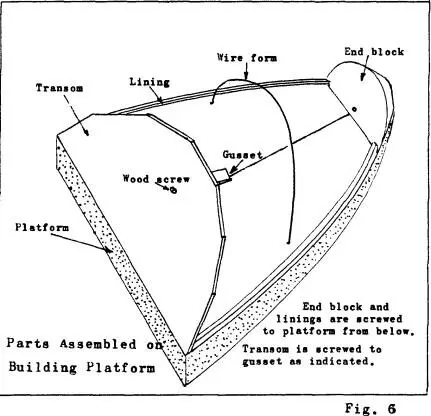
Here comes the first design option. Do you want a solid transom or one which is veneered? If you have an unusual piece of hardwood 1/4 x 4 3/4 x 16 1/2" with an attractive and symmetrical grain pattern, then go the solid route. If you prefer the transom to be more decorative by veneering pie-shaped wedges on the face then go that way. I personally find that the veneered transom is more attractive and preferred. Going the veneer route you will need a piece of light well-seasoned wood 3/16 x 4 3/ 4x 16 1/ 2". I have been using some yellow poplar (Liriodendron tulipifera L.) from a seventy five year old porch pole. A tight grained piece of softwood such as spruce makes a fine transom base. Do not use a heavy hardwood as you will be adding unnecessary weight to the instrument. Cut the transom in accordance with the dimensions indicated in Fig. 7. A convenient way half of the transom. With a sharp pointed instrument, pierce the paper at the apex of all angles thus making a mark on the wood. Reverse the pattern and make similar marks on the other half. Then draw lines to each of these points as the pattern suggests. Do not cut the wood at this point as you will notice that these cuts are not at right angles. I cut my transoms on a band saw and make necessary angle adjustments with the table. Proceed to cut the shape of the transom after the above caution has been noted.
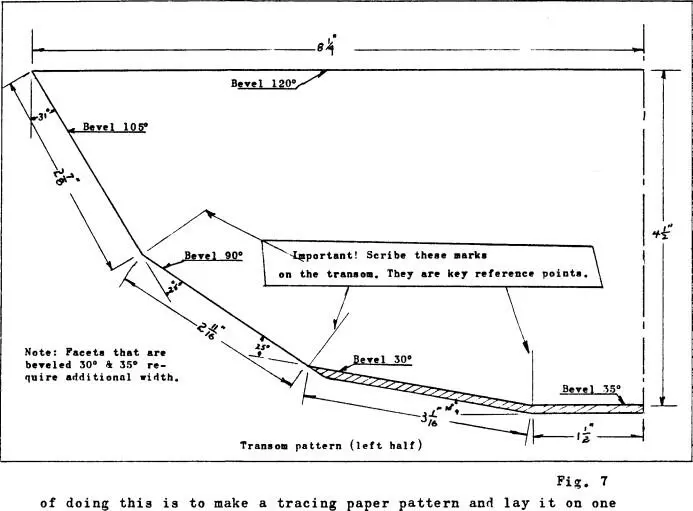
Please take note that we have elected to make a seven (7) rib instrument. Table I indicates that the prima balalaika can be either a six or seven ribbed instrument. Also pay particular attention to the notes shown in Fig. 7, especially the need to make pencil marks on the transom at the angles where each rib joins another. This is necessary because in the process of fitting the ribs to each other and at the transom, some light sanding and scraping may be necessary, thus making the location of the apex unclear. Making the transom is one of the tricky components of the balalaika and apt to cause some consternation. If you look at the transom broadside it follows the lines of an ellipse. The ribs are chords on this ellipse and herein lies the problem. You can divide this elliptical "half" curve into seven equal chords (segments) for the ribs. When doing this you end up with a different angle where each rib joins its adjacent one. With a seven ribbed instrument this requires three different bevels (three joints on each side of center) where the ribs butt each other. Further, the angle between the center rib and the two on each side of it is very slight. I prefer to reduce the number of different angles for butting the ribs by making the ribs slightly dissimilar in width as they join the transom. Further, the angles are then workable ones. There is room for experimenting here and no sacred design is prescribed. Put the transom aside for the moment.
Making the two side linings is the next step. In lutherie terminology, a lining is a strip of wood used on the inside of an instrument to enlarge an edge so as to provide a wider surface upon which the top or bottom is glued. The side linings for the balalaika are made from l/2" square spruce (or other suitable species) and are bent on a hot iron. Lets take a moment and discuss the assembly of a home-made and effective bending rig. This is shown in Fig. 8. I clamp this iron to the workbench and clamp a 14 oz, propane cylinder in a vise and aim the burner head into the pipe. I place scraps of metal in the pipe to act as baffles and diffuse the flame. Now back to the linings.
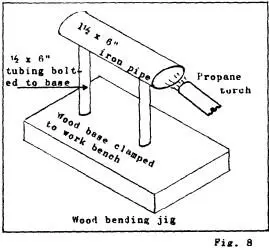
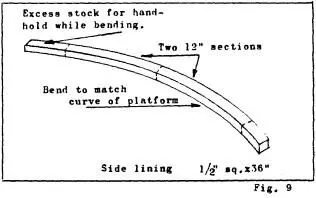
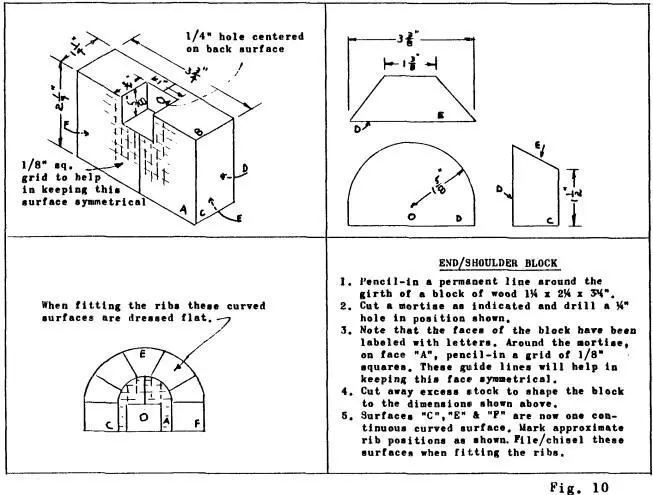
Uncover the platform you laid aside earlier. Moisten the 1/ 2x 1/ 2x 36" piece of lining and bend it over the hot iron to conform to the shape of the curve on the platform. See Fig. 9. While this piece is a little long, it will produce a lining for both sides with enough to hold the wood while it is on the hot iron. In operations such as this I generally make a few extra pieces. It is much more economical in terms of time to crank out several pieces while the special rig is set up. The lining is now curved and square. It will
Читать дальшеИнтервал:
Закладка:
Похожие книги на «Building the Balalaika»
Представляем Вашему вниманию похожие книги на «Building the Balalaika» списком для выбора. Мы отобрали схожую по названию и смыслу литературу в надежде предоставить читателям больше вариантов отыскать новые, интересные, ещё непрочитанные произведения.
Обсуждение, отзывы о книге «Building the Balalaika» и просто собственные мнения читателей. Оставьте ваши комментарии, напишите, что Вы думаете о произведении, его смысле или главных героях. Укажите что конкретно понравилось, а что нет, и почему Вы так считаете.
